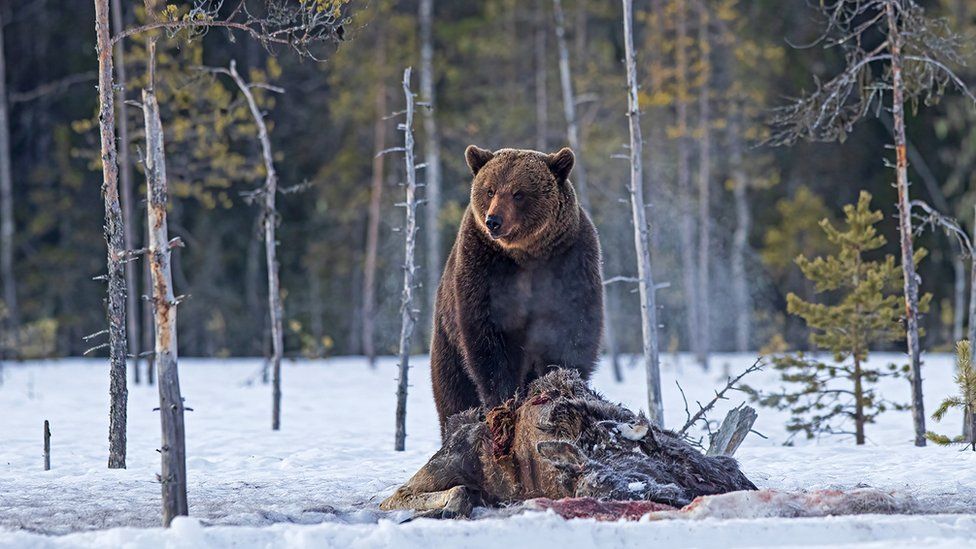Bear photography takes great-grandmother round the world
- Published

When Jenny Hibbert turned to photography as a distraction during her difficult divorce, little did she know it would take her around the globe and bring her face to face with some of the world's largest predators.
The great-grandmother, 70, has visited Mongolia, where she walked up to 19 miles a day in -25C (-13F) conditions.
She has also travelled to the Arctic, where she was chased by a polar bear, as well as Japan and Poland.
But her favourite place is Finland where she photographs Europe's largest predator - the brown bear.
Now one of her pictures is part of an exhibition that will travel around the UK and is currently at Swansea's Quadrant Shopping Centre.
Her photo of a brown bear guarding its kill, a moose, was taken on her most recent trip to Finland in April.
Jenny, who has four children, 10 grandchildren and two great-grandchildren, has always loved photography and was given her first camera for Christmas when she was 11.
She was 62 when she bought herself her first digital camera.
"I was going through a really messy divorce," said Jenny, who lives in Margam, Neath Port Talbot.
"Any divorce is a nightmare. It kind of took my mind off everything so I threw myself into photography."
She began taking photos of Welsh landscapes and wildlife, such as Skomer's puffins, and released a photography book about dippers on the River Ogmore.
She then began taking photography trips abroad, but capturing the photos featured in the exhibition was an arduous task.
"Basically I was in a hide for 16 hours," she said.
"You sleep in this hide, it's extremely cold, probably -20C... the only bit of heat I had was nine little candles.
"And you're just there, hoping that a bear or two, which would be even better, will turn up."
Her patience paid off.
"This bear came in the early hours of the morning, so it was really hoar frost and covered," she said.
"It was just an amazing time to be able to photograph this bear with the dead moose that was there because they'd just come out of hibernation."
Photographing bears is not without its risks and Jenny has found herself in a hairy spot on more than one occasion.
In 2010, she and a small group of photographers sailed around the Arctic in a yacht.
After days on board they finally got to spend some time on land, but it was short-lived.
"We got chased off the beach by a polar bear, which was extremely scary - we just had to run," said Jenny.
Then, while on a trip to Finland in 2020, a hungry bear was drawn to the chocolate she had with her in her hide.
"This brown bear could smell it and was trying to get into the hide - so you're just banging on the side of this hide to scare it away," she said.
"Your mobile phones don't work because you're out in the wilderness, so yes, it was quite scary."
One of her most challenging adventures was a trip to Mongolia in 2016, travelling with the Kazakhs, a nomadic ethnic group.
Before being selected to go on the trip she had to demonstrate she could get on with people, was fit enough to walk up to 19 miles a day and could withstand very cold conditions.
During the trip she slept on a mattress on the floor of a Mongolian ger in -35C (-31F) conditions.
"This just shows you how stupid I was, or naïve, the first night I changed into my pyjamas and I couldn't understand why people were wearing their thermals, their hats," she chuckled.
"Well, that was the first time and the last time that I ever did that."
She would sleep with her wet wipes and her toothpaste to try and stop them from freezing overnight.
She said spending time with the Kazakhs was a privilege.
"It is a really hard life for them, extremely hard, and yet they are the happiest people that you could possibly meet," she said.
"The children have absolutely nothing or very few things - a tatty party pack of cards and a really scruffy little teddy - but they were lovely and they just got on with it."
She said she loved the photos she took of the children and the animals.
One photo was taken after a camel lost its calf when it wandered off and got lost during a storm.
"She was just calling for this young camel and it was awful to hear, it was really heart-breaking," said Jenny.
Thankfully the Kazakhs found the calf safe and well and it was reunited with its mother.
Another of her photos shows the group loading one of their cows, which had become exhausted, on to a truck.
"That just shows you how really important their animals are to them," said Jenny.
Jenny, who is president of the Welsh Photographic Federation, has enjoyed success as a photographer.
She earned herself the nickname Miss September in her camera club after her photographs were featured on the BBC Countryfile calendar for both September 2016 and September 2022.
She said she hopes one day she will be able to go to Alaska to photograph bears catching salmon and Yellowstone National Park in the winter.
But for now she is spending her time in Swansea, manning the Photographic Alliance of Great Britain's Inter-Federation Exhibition.
It features 150 photographs from photographers across the UK, selected from a collection of 1,300.
The Photographic Alliance of Great Britain's Inter-Federation Exhibition will be in Swansea's Quadrant Shopping Centre until 30 July.
- EXPLORE ANGLESEY'S RICH WILDLIFE: Iolo explore Wales’ biggest island by land and sea
- ICONIC WELSH PEOPLE, PLACES AND THINGS: Kiri unearths the best clips from the BBC Wales archive
- Published5 July 2022
- Published15 July 2022
- Published17 July 2022
- Published21 June 2022